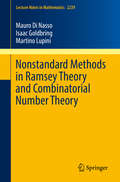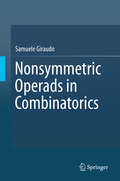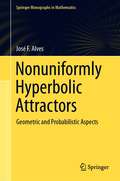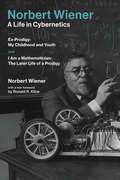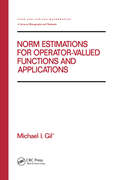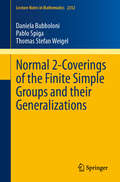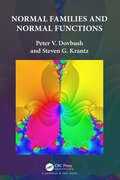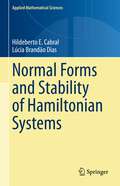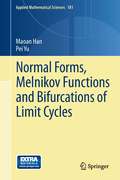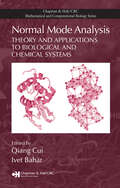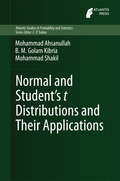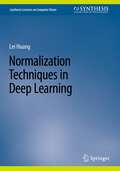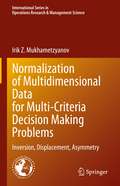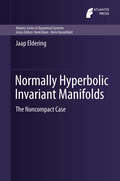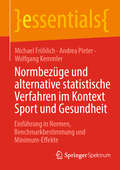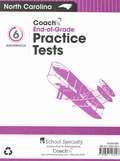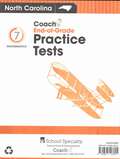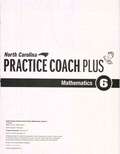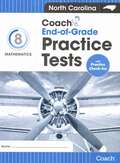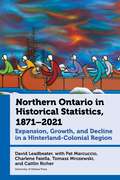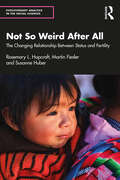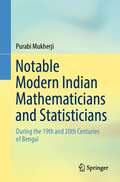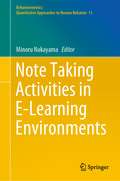- Table View
- List View
Nonstandard Methods in Ramsey Theory and Combinatorial Number Theory (Lecture Notes in Mathematics #2239)
by Martino Lupini Isaac Goldbring Mauro Di NassoThe goal of this monograph is to give an accessible introduction to nonstandard methods and their applications, with an emphasis on combinatorics and Ramsey theory. It includes both new nonstandard proofs of classical results and recent developments initially obtained in the nonstandard setting. This makes it the first combinatorics-focused account of nonstandard methods to be aimed at a general (graduate-level) mathematical audience. This book will provide a natural starting point for researchers interested in approaching the rapidly growing literature on combinatorial results obtained via nonstandard methods. The primary audience consists of graduate students and specialists in logic and combinatorics who wish to pursue research at the interface between these areas.
Nonsymmetric Operads in Combinatorics (SpringerBriefs in Computer Science)
by Samuele GiraudoOperads are algebraic devices offering a formalization of the concept of operations with several inputs and one output. Such operations can be naturally composed to form more complex ones. Coming historically from algebraic topology, operads intervene now as important objects in computer science and in combinatorics. A lot of operads involving combinatorial objects highlight some of their properties and allow to discover new ones.This book portrays the main elements of this theory under a combinatorial point of view and exposes the links it maintains with computer science and combinatorics. Examples of operads appearing in combinatorics are studied. The modern treatment of operads consisting in considering the space of formal power series associated with an operad is developed. Enrichments of nonsymmetric operads as colored, cyclic, and symmetric operads are reviewed.
Nonuniformly Hyperbolic Attractors: Geometric and Probabilistic Aspects (Springer Monographs in Mathematics)
by José F. AlvesThis monograph offers a coherent, self-contained account of the theory of Sinai–Ruelle–Bowen measures and decay of correlations for nonuniformly hyperbolic dynamical systems. A central topic in the statistical theory of dynamical systems, the book in particular provides a detailed exposition of the theory developed by L.-S. Young for systems admitting induced maps with certain analytic and geometric properties. After a brief introduction and preliminary results, Chapters 3, 4, 6 and 7 provide essentially the same pattern of results in increasingly interesting and complicated settings. Each chapter builds on the previous one, apart from Chapter 5 which presents a general abstract framework to bridge the more classical expanding and hyperbolic systems explored in Chapters 3 and 4 with the nonuniformly expanding and partially hyperbolic systems described in Chapters 6 and 7. Throughout the book, the theory is illustrated with applications. A clear and detailed account of topics of current research interest, this monograph will be of interest to researchers in dynamical systems and ergodic theory. In particular, beginning researchers and graduate students will appreciate the accessible, self-contained presentation.
Norbert Wiener#A Life in Cybernetics: Ex-Prodigy: My Childhood and Youth and I Am a Mathematician: The Later Life of a Prodigy (The\mit Press Ser.)
by Norbert WienerNorbert Wiener's celebrated autobiography, available for the first time in one volume.Norbert Wiener—A Life in Cybernetics combines for the first time the two volumes of Norbert Wiener's celebrated autobiography. Published at the height of public enthusiasm for cybernetics—when it was taken up by scientists, engineers, science fiction writers, artists, and musicians—Ex-Prodigy (1953) and I Am a Mathematician (1956) received attention from both scholarly and mainstream publications, garnering reviews and publicity in outlets that ranged from the New York Times and New York Post to the Virginia Quarterly Review. Norbert Wiener was a mathematician with extraordinarily broad interests. The son of a Harvard professor of Slavic languages, Wiener was reading Dante and Darwin at seven, graduated from Tufts at fourteen, and received a PhD from Harvard at eighteen. He joined MIT's Department of Mathematics in 1919, where he remained until his death in 1964 at sixty-nine. In Ex-Prodigy, Wiener offers an emotionally raw account of being raised as a child prodigy by an overbearing father. In I Am a Mathematician, Wiener describes his research at MIT and how he established the foundations for the multidisciplinary field of cybernetics and the theory of feedback systems. This volume makes available the essence of Wiener's life and thought to a new generation of readers.
Norm Estimations for Operator Valued Functions and Their Applications
by Michael I. Gil'Intended for specialists in functional analysis and stability theory, this work presents a systematic exposition of estimations for norms of operator-valued functions, and applies the estimates to spectrum perturbations of linear operators and stability theory. The author demonstrates his own approach to spectrum perturbations.
Normal 2-Coverings of the Finite Simple Groups and their Generalizations (Lecture Notes in Mathematics #2352)
by Pablo Spiga Daniela Bubboloni Thomas Stefan WeigelThis book provides a complete and comprehensive classification of normal 2-coverings of non-abelian simple groups and their generalizations. While offering readers a thorough understanding of these structures, and of the groups admitting them, it delves into the properties of weak normal coverings. The focal point is the weak normal covering number of a group G, the minimum number of proper subgroups required for every element of G to have a conjugate within one of these subgroups, via an element of Aut(G). This number is shown to be at least 2 for every non-abelian simple group and the non-abelian simple groups for which this minimum value is attained are classified. The discussion then moves to almost simple groups, with some insights into their weak normal covering numbers. Applications span algebraic number theory, combinatorics, Galois theory, and beyond. Compiling existing material and synthesizing it into a cohesive framework, the book gives a complete overview of this fundamental aspect of finite group theory. It will serve as a valuable resource for researchers and graduate students working on non-abelian simple groups,
Normal Families and Normal Functions
by Steven G. Krantz Peter V. DovbushThis book centers on normal families of holomorphic and meromorphic functions and also normal functions. The authors treat one complex variable, several complex variables, and infinitely many complex variables (i.e., Hilbert space).The theory of normal families is more than 100 years old. It has played a seminal role in the function theory of complex variables. It was used in the first rigorous proof of the Riemann mapping theorem. It is used to study automorphism groups of domains, geometric analysis, and partial differential equations.The theory of normal families led to the idea, in 1957, of normal functions as developed by Lehto and Virtanen. This is the natural class of functions for treating the Lindelof principle. The latter is a key idea in the boundary behavior of holomorphic functions.This book treats normal families, normal functions, the Lindelof principle, and other related ideas. Both the analytic and the geometric approaches to the subject area are offered. The authors include many incisive examples.The book could be used as the text for a graduate research seminar. It would also be useful reading for established researchers and for budding complex analysts.
Normal Forms and Stability of Hamiltonian Systems (Applied Mathematical Sciences #218)
by Hildeberto E. Cabral Lúcia Brandão DiasThis book introduces the reader to the study of Hamiltonian systems, focusing on the stability of autonomous and periodic systems and expanding to topics that are usually not covered by the canonical literature in the field. It emerged from lectures and seminars given at the Federal University of Pernambuco, Brazil, known as one of the leading research centers in the theory of Hamiltonian dynamics. This book starts with a brief review of some results of linear algebra and advanced calculus, followed by the basic theory of Hamiltonian systems. The study of normal forms of Hamiltonian systems is covered by Ch.3, while Chapters 4 and 5 treat the normalization of Hamiltonian matrices. Stability in non-linear and linear systems are topics in Chapters 6 and 7. This work finishes with a study of parametric resonance in Ch. 8. All the background needed is presented, from the Hamiltonian formulation of the laws of motion to the application of the Krein-Gelfand-Lidskii theory of strongly stable systems. With a clear, self-contained exposition, this work is a valuable help to advanced undergraduate and graduate students, and to mathematicians and physicists doing research on this topic.
Normal Forms, Melnikov Functions and Bifurcations of Limit Cycles
by Maoan Han Pei YuDynamical system theory has developed rapidly over the past fifty years. It is a subject upon which the theory of limit cycles has a significant impact for both theoretical advances and practical solutions to problems. Hopf bifurcation from a center or a focus is integral to the theory of bifurcation of limit cycles, for which normal form theory is a central tool. Although Hopf bifurcation has been studied for more than half a century, and normal form theory for over 100 years, efficient computation in this area is still a challenge with implications for Hilbert's 16th problem. This book introduces the most recent developments in this field and provides major advances in fundamental theory of limit cycles. Split into two parts, the first focuses on the study of limit cycles bifurcating from Hopf singularity using normal form theory with later application to Hilbert's 16th problem, while the second considers near Hamiltonian systems using Melnikov function as the main mathematical tool. Classic topics with new results are presented in a clear and concise manner and are accompanied by the liberal use of illustrations throughout. Containing a wealth of examples and structured algorithms that are treated in detail, a good balance between theoretical and applied topics is demonstrated. By including complete Maple programs within the text, this book also enables the reader to reconstruct the majority of formulas provided, facilitating the use of concrete models for study. Through the adoption of an elementary and practical approach, this book will be of use to graduate mathematics students wishing to study the theory of limit cycles as well as scientists, across a number of disciplines, with an interest in the applications of periodic behavior.
Normal Mode Analysis: Theory and Applications to Biological and Chemical Systems (Chapman & Hall/CRC Mathematical Biology Series)
by Qiang Cui Ivet BaharRapid developments in experimental techniques continue to push back the limits in the resolution, size, and complexity of the chemical and biological systems that can be investigated. This challenges the theoretical community to develop innovative methods for better interpreting experimental results. Normal Mode Analysis (NMA) is one such technique
Normal and Student´s t Distributions and Their Applications
by Mohammad Ahsanullah B. M. Golam Kibria Mohammad ShakilThe most important properties of normal and Student t-distributions are presented. A number of applications of these properties are demonstrated. New related results dealing with the distributions of the sum, product and ratio of the independent normal and Student distributions are presented. The materials will be useful to the advanced undergraduate and graduate students and practitioners in the various fields of science and engineering.
Normalization Techniques in Deep Learning (Synthesis Lectures on Computer Vision)
by Lei HuangThis book presents and surveys normalization techniques with a deep analysis in training deep neural networks. In addition, the author provides technical details in designing new normalization methods and network architectures tailored to specific tasks. Normalization methods can improve the training stability, optimization efficiency, and generalization ability of deep neural networks (DNNs) and have become basic components in most state-of-the-art DNN architectures. The author provides guidelines for elaborating, understanding, and applying normalization methods. This book is ideal for readers working on the development of novel deep learning algorithms and/or their applications to solve practical problems in computer vision and machine learning tasks. The book also serves as a resource researchers, engineers, and students who are new to the field and need to understand and train DNNs.
Normalization of Multidimensional Data for Multi-Criteria Decision Making Problems: Inversion, Displacement, Asymmetry (International Series in Operations Research & Management Science #348)
by Irik Z. MukhametzyanovThis book presents a systematic review of multidimensional normalization methods and addresses problems frequently encountered when using various methods and ways to eliminate them. The invariant properties of the linear normalization methods presented here can be used to eliminate simple problems and avoid obvious errors when choosing a normalization method. The book introduces valuable, novel techniques for the multistep normalization of multidimensional data. One of these methods involves inverting the normalized values of cost attributes into profit attributes based on the reverse sorting algorithm (ReS algorithm). Another approach presented is the IZ method, which addresses the issue of shift in normalized attribute values. Additionally, a new method for normalizing the decision matrix is proposed, called the MS method, which ensures the equalization of average values and variances of attributes. Featuring numerous illustrative examples throughout, the book helps readers to understand what difficulties can arise in multidimensional normalization, what to expect from such problems, and how to solve them. It is intended for academics and professionals in various areas of data science, computing in mathematics, and statistics, as well as decision-making and operations.
Normally Hyperbolic Invariant Manifolds: The Noncompact Case
by Jaap ElderingThis monograph treats normally hyperbolic invariant manifolds, with a focus on noncompactness. These objects generalize hyperbolic fixed points and are ubiquitous in dynamical systems. First, normally hyperbolic invariant manifolds and their relation to hyperbolic fixed points and center manifolds, as well as, overviews of history and methods of proofs are presented. Furthermore, issues (such as uniformity and bounded geometry) arising due to noncompactness are discussed in great detail with examples. The main new result shown is a proof of persistence for noncompact normally hyperbolic invariant manifolds in Riemannian manifolds of bounded geometry. This extends well-known results by Fenichel and Hirsch, Pugh and Shub, and is complementary to noncompactness results in Banach spaces by Bates, Lu and Zeng. Along the way, some new results in bounded geometry are obtained and a framework is developed to analyze ODEs in a differential geometric context. Finally, the main result is extended to time and parameter dependent systems and overflowing invariant manifolds.
Normbezüge und alternative statistische Verfahren im Kontext Sport und Gesundheit: Einführung in Normen, Benchmarkbestimmung und Minimum-Effekte (essentials)
by Michael Fröhlich Andrea Pieter Wolfgang KemmlerIm Sport und im Gesundheitswesen sind Normen, Normwerte und Normwertbezüge wesentlich, wenn es darum geht, Informationen zu sportlichen, physiologischen, psychologischen und/oder gesundheitlichen Kenngrößen qualitativ und quantitativ einzuschätzen. Einfache und etablierte Verfahren und Methoden zu deskriptiven, graphischen und numerischen Normwertdarstellungen sowie zu alternativen statistischen Verfahren der Normwerteinschätzung werden erläutert.
North Carolina Coach End-of-Grade Practice Tests, Mathematics, Grade 6
by Inc. School SpecialtyNorth Carolina Coach End-of-Grade Practice Tests, Mathematics, Grade 6
North Carolina Practice Coach PLUS, Mathematics, Grade 7
by North Carolina Practice CoachNorth Carolina Practice Coach PLUS, Mathematics, Grade 7 content includes: Domain 1 The Number System, North Carolina Standard Course of Study, Domain 2 Ratios and Proportional Relationships, Domain 3 Expressions and Equations, Domain 4 Geometry, Domain 5 Statistics and Probability, Glossary.
North Carolina Practice Coach PLUS, Mathematics, Grade 8
by North Carolina Practice CoachNorth Carolina Practice Coach PLUS, Mathematics, Grade 8 content includes: Domain 1 The Number System, North Carolina Standard Course of Study, Domain 2 Expressions and Equations, Domain 3 Functions, Domain 4 Geometry, Domain 5 Statistics and Probability, Glossary
North Carolina Practice Coach Plus Grade 7 Practice Tests
by School Specialty IncNORTH CAROLINA PRACTICE COACH PLUS MATH GRADE 7 PRACTICE TESTS with Practice Check-Ins
North Carolina Practice Coach Plus Math Grade 6
by Triumph Learning LlcNORTH CAROLINA PRACTICE COACH PLUS, MATHEMATICS, GRADE 6
North Carolina Practice Coach Plus Math Grade 8 Practice Tests
by Inc. School SpecialtyNORTH CAROLINA PRACTICE COACH PLUS MATH GRADE 8 PRACTICE TESTS with Practice Check-Ins
Northern Ontario in Historical Statistics, 1871–2021: Expansion, Growth, and Decline in a Hinterland-Colonial Region (Canadian Studies #10)
by Professor David LeadbeaterBased on original historical tables, Northern Ontario in Historical Statistics, 1871–2021 offers an overview of major long-term population, social composition, employment, and urban concentration trends over 150 years in the region now called “Northern Ontario” (or “Nord de l’Ontario”). David Leadbeater and his collaborators compare Northern Ontario relative to Southern Ontario, as well as detail changes at the district and local levels. They also examine the employment population rate, unemployment, economic dependency, and income distribution, particularly over recent decades of decline since the 1970s.Although deeply experienced by Indigenous peoples, the settler-colonial structure of Northern Ontario’s development plays little explicit analytical role in official government discussions and policy.Northern Ontario in Historical Statistics, 1871–2021, therefore, aims to provide context for the long-standing hinterland colonial question: How do ownership, control, and use of the land and its resources benefit the people who live there?Leadbeater and his collaborators pay special attention to foundational conditions in Northern Ontario’s hinterland-colonial development including Indigenous relative to settler populations, treaty and reserve areas, and provincially controlled “unorganized territories.” Colonial biases in Canadian censuses are discussed critically as a contribution towards decolonizing changes in official statistics.
Not So Weird After All: The Changing Relationship Between Status and Fertility (Evolutionary Analysis in the Social Sciences)
by Rosemary L. Hopcroft Martin Fieder Susanne HuberThis is the first book to fully examine, from an evolutionary point of view, the association of social status and fertility in human societies before, during, and after the demographic transition. In most nonhuman social species, social status or relative rank in a social group is positively associated with the number of offspring, with high-status individuals typically having more offspring than low-status individuals. However, humans appear to be different. As societies have gotten richer, fertility has dipped to unprecedented lows, with some developed societies now at or below replacement fertility. Within rich societies, women in higher-income families often have fewer children than women in lower-income families. Evolutionary theory suggests that the relationship between social status and fertility is likely to be somewhat different for men and women, so it is important to examine this relationship for men and women separately. When this is done, the positive association between individual social status and fertility is often clear in less-developed, pre-transitional societies, particularly for men. Once the demographic transition begins, it is elite families, particularly the women of elite families, who lead the way in fertility decline. Post-transition, the evidence from a variety of developed societies in Europe, North America and East Asia is that high-status men (particularly men with high personal income) do have more children on average than lower-status men. The reverse is often true of women, although there is evidence that this is changing in Nordic countries. The implications of these observations for evolutionary theory are also discussed. This book will be of interest to students and researchers in the social sciences with an interest in evolutionary sociology, evolutionary anthropology, evolutionary psychology, demography, and fertility.
Notable Modern Indian Mathematicians and Statisticians: During the 19th and 20th Centuries of Bengal
by Purabi MukherjiThis book provides a comprehensive portrayal of the history of Indian mathematicians and statisticians and uncovers many missing parts of the scientific representation of mathematical and statistical research during the 19th and 20th centuries of Bengal (now West Bengal), India. This book gives a brief historical account about the establishment of the first-two departments in an Indian university, where graduate teaching and research were initiated. This was a unique distinction for the University of Calcutta which was established in 1857. The creation of the world famous Indian Statistical Institute (ISI) in Calcutta (now Kolkata) is also briefly described. The lives and works of the 16 pioneer mathematical scientists who adorned the above mentioned institutions and the first Indian Institute Technology (IIT) of India have been elaborated in lucid language. Some outstanding scholars who were trained at the ISI but left India permanently have also been discussed briefly in a separate chapter. This book fulfils a long-standing gap in the history of modern Indian mathematics, which will make the book very useful to researchers in the history of science and mathematics. Written in very lucid English with little mathematical or statistical jargon makes the book immensely readable even to general readers with interest in scientific history even from non-mathematical, non-statistical background. This book is a clear portrayal of the struggle and success of researchers in mathematical sciences in Bengal (an important part of the colonial India), unveils before the international community of mathematical scientists. The real connoisseurs will appreciate the value of the book, as it will clear up many prevailing misconceptions.
Note Taking Activities in E-Learning Environments (Behaviormetrics: Quantitative Approaches to Human Behavior #11)
by Minoru NakayamaThe main focus of this book is presenting practical procedures for improving learning effectiveness using note taking activities during e-learning courses. Although presentation of e-learning activities recently has been spreading to various education sectors, some practical problems have been discussed such as evaluation of learning performance and encouragement of students. The authors introduce note taking activity as a conventional learning tool in order to promote individual learning activity and learning efficacy. The effectiveness of note taking has been measured in practical teaching in a Japanese university using techniques of learning analytics, and the results are shown here. The relationships between note taking activity and students’ characteristics, the possibility of predicting the final learning performance using metrics of students’ note taking, and the effectiveness for individual emotional learning factors are evaluated. Some differences between blended learning and fully online learning courses are also discussed. The authors provide novel analytical procedures and ideas to manage e-learning courses. In particular, the assessment of note taking activity may help to track individual learning progress and to encourage learning motivation.
